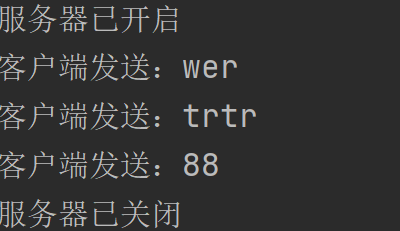import java.io.DataInputStream;
import java.io.DataOutputStream;
import java.io.IOException;
import java.net.Socket;
import java.net.UnknownHostException;
import java.util.Scanner;
public class TestSockClient {
public static void main(String[] args) {
DataInputStream dis = null;
DataOutputStream dos = null;
Socket socket = null;
Scanner scan = null;
String sendStr;
String receiveStr;
try {
socket = new Socket("localhost", 8888);
dis = new DataInputStream(socket.getInputStream());
dos = new DataOutputStream( socket.getOutputStream());
scan = new Scanner(System.in);
do {
System.out.print("我:");
sendStr = scan.nextLine();
dos.writeUTF(sendStr);
if ((receiveStr = dis.readUTF()) != null) {
System.out.println(receiveStr);
}
} while (!sendStr.equals("88"));
} catch (UnknownHostException e) {
e.printStackTrace();
} catch (IOException e) {
e.printStackTrace();
} catch (Exception e) {
e.printStackTrace();
}
finally {
try {
dis.close();
dos.close();
socket.close();
scan.close();
} catch (IOException e) {
e.printStackTrace();
}
}
}
}
import java.io.DataInputStream;
import java.io.DataOutputStream;
import java.io.EOFException;
import java.io.IOException;
import java.net.ServerSocket;
import java.net.Socket;
public class TestSockServer {
public static void main(String[] args) {
ServerSocket server = null;
Socket socket = null;
DataOutputStream dos = null;
DataInputStream dis = null;
try{
server = new ServerSocket(8888);
System.out.println("服务器已开启");
socket = server.accept();
dos = new DataOutputStream(socket.getOutputStream());
dis = new DataInputStream(socket.getInputStream());
String receiveStr ;
while((receiveStr = dis.readUTF())!= null) {
System.out.println("客户端发送:"+receiveStr);
dos.writeUTF("Tom:"+receiveStr);
}
} catch(EOFException e) {
System.out.println("服务器已关闭");
}catch(IOException e){
e.printStackTrace();
}catch (Exception e) {
e.printStackTrace();
}
finally{
try{
dis.close();
dos.close();
socket.close();
server.close();
}catch(IOException e){
e.printStackTrace();
}
}
}
}
- 运行结果

